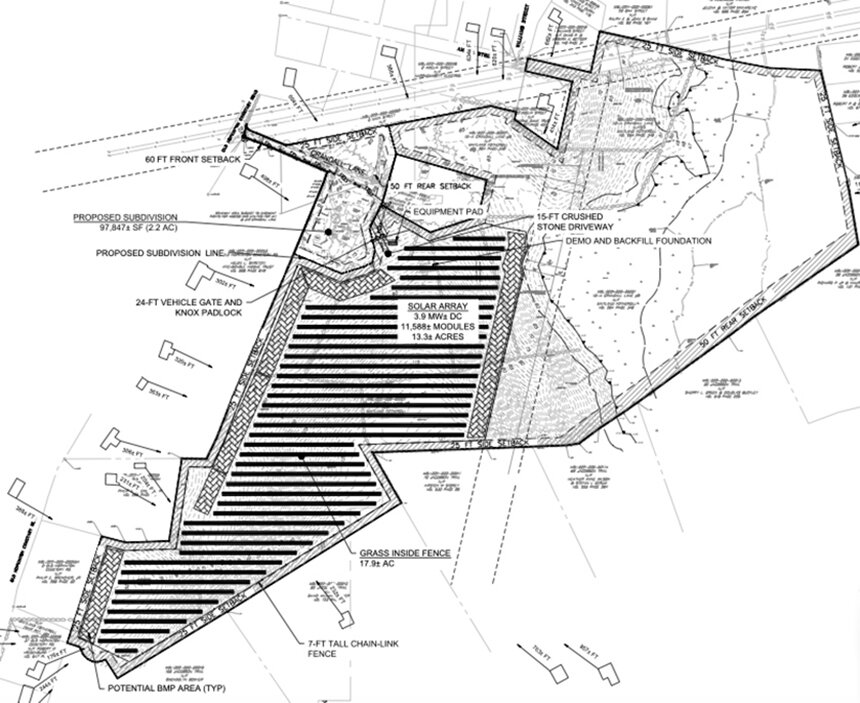Town Council could ignore board’s
advisory opinion as it has a handful of other times
By TIM FAULKNER/ecoRI
News staff
 ,
,
Thirteen acres of trees would be cleared for the latest solar proposal in Hopkinton, a 3.9-megawatt project off Old Hopkinton Cemetery Road. (ESS Group)
Developers continue to eye farms and forest for building utility-scale solar arrays in this rural community in southwest Rhode Island.
The latest proposal is a
3.9-megawatt system for a hillside off Old Hopkinton Cemetery Road. On paper,
the Fothergill-Crandall Lane solar
array occupies 46 acres of woodlands and wetlands, including a swamp
and stream.
About 13 acres of trees would be cleared to make way for 11,588 solar panels. The property is owned by Maitland Fothergill of Cumberland. The applicant is Centrica Business Solutions, a global energy company based in the United Kingdom.
About 13 acres of trees would be cleared to make way for 11,588 solar panels. The property is owned by Maitland Fothergill of Cumberland. The applicant is Centrica Business Solutions, a global energy company based in the United Kingdom.
The Planning Board, however, isn’t
happy with this ground-mounted solar project — one of some two dozen that have
been approved or proposed during the past several years.
“If we continue to remove forests of
this size, we will be paying literally and figuratively for decades,” Planning
Board member Emily Shumchenia said.
Shumchenia made the comment just before the Planning Board voted unanimously on July 1 to oppose a zoning change for the proposed solar project.
Shumchenia and three other Planning Board members — board chair Alfred
DiOrio recused himself from the hearing and the vote because he has previously
done surveying work for one of the applicants — agreed that the project doesn’t
conform with the town’s comprehensive plan.
They said the project fails to fulfill the plan’s goals of preserving natural resources and protecting the town’s rural character. They noted that the project would eliminate prime farmland and wildlife habitat.
They said the project fails to fulfill the plan’s goals of preserving natural resources and protecting the town’s rural character. They noted that the project would eliminate prime farmland and wildlife habitat.
Shumchenia referred to a 2019 study by the Rhode
Island Department of Environmental Management that shows how trees save money.
An acre of trees filters thousands of gallons of water annually.
A forest provides significant ecosystem services, such as air filtration and carbon storage. One large tree can transpire as much as 100 gallons a day and provide the cooling equivalent to running five air conditioners for 20 hours, according to the 133-page study.
A forest provides significant ecosystem services, such as air filtration and carbon storage. One large tree can transpire as much as 100 gallons a day and provide the cooling equivalent to running five air conditioners for 20 hours, according to the 133-page study.
Shumchenia said the
Fothergill-Crandall Lane project is “not well conceived” and would cause “huge
changes to the character of the neighborhood.”
Local residents and abutters of the
proposed developed, which boarders a relatively densely built residential area,
questioned technical aspects of the project. They wanted to know why new rules
limiting solar projects to 3 acres and rigid setbacks from property lines was
disregarded in favor of a 13-acre array and 25-foot setbacks.
Town planner Jim Lamphere
explained that the application was submitted just before the town’s new
solar-siting rules took effect in January 2019, grandfathering it from the new
rules. Residents, however, noted that the application was changed within the
last month, and thus the project should have to adhere to the new regulations.
“The fact that the plans were changed
at the last minute and none of the townspeople surrounding this area were aware
of these changes alone should scrap the entire plan,” resident Robert Henninger
said.
Henninger and other residents
mentioned the deer, bobcats, and woodpeckers displaced by other solar
facilities developed in town.
“It’s absolutely ridiculous that we
have to keep having meetings about solar arrays going in our town,” Henninger
said. “It’s quite clear that the townspeople don’t want this. The fact that
they are going into a residential area as commercial is absolutely ridiculous.”
Town Council member Sharon Davis
attended the online meeting as the council’s liaison. Davis said she preferred
300-foot buffers for this solar project instead of the 25-foot ones used for
other projects.
“The abutters have really suffered
under these dimensions in the past,” Davis said.
An attorney representing neighbors
who oppose the project raised a point that may give more finality to future
Planning Board decisions in Hopkinton and elsewhere. Peter Skwirz, a municipal
law attorney, argued that state law gives planning boards, not town and city
councils, the final say over proposed zoning amendments to comprehensive plans.
“The main issue is the applicant is
asking the town to make a one-off change to its comprehensive plan, to
essentially squeeze a non-residential use into what would otherwise be a
residential zone,” Skwirz said. “It’s not appropriate as a matter of policy,
it’s not appropriate with the Comprehensive Planning Land Use Act.”
For now, the decision by the
Planning Board is an advisory opinion for the Town Council to consider. The
council was expected to vote on the rezoning request during its July 6 meeting,
but Centrica Business Solutions was granted a postponement until Aug. 17.
The Town Council has been much friendlier to utility-scale
solar installations than the Planning Board, often ignoring other
unfavorable advisory opinions in favor of the tax revenue that these large
energy projects bring to the town. In all, the Town Council has approved zoning
changes for seven commercial solar projects and denied four.
If the latest zoning change is
approved, a more detailed plan of the Fothergill-Crandall Lane solar project
will go back before the Planning Board for review.